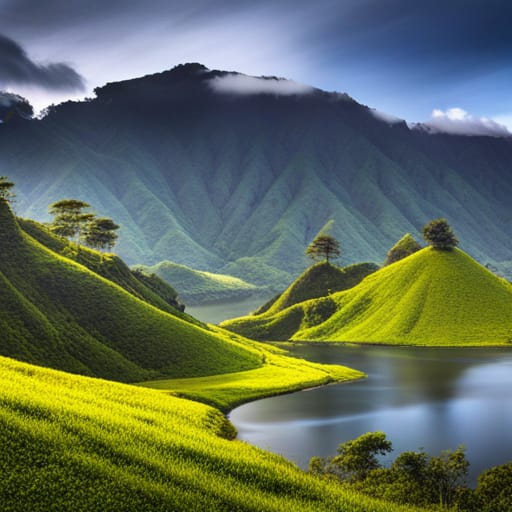
Discovering The Best Time to Travel to Indonesia:
Sept 26, 2023
Introduction:
“The Best Time to Travel to Indonesia” – While Indonesia is a fantastic destination year-round, let’s explore when to make your journey even more extraordinary.
With its enchanting beauty and diverse landscapes, Indonesia is a dream destination for travellers seeking tropical adventures. From pristine beaches and vibrant coral reefs to lush rainforests and ancient temples, this captivating archipelago offers many experiences. However, to make the most of your Indonesian journey, knowing the best time to visit and the must-visit destinations that showcase the country’s unique charm is essential.
Today, we will explore the ideal time to travel to Indonesia and highlight some of the top destinations that should be on every traveller’s itinerary. Whether you’re seeking relaxation on sun-kissed shores or yearning for cultural immersion, Indonesia has something to offer for everyone. So, let’s embark on a virtual journey and discover the best time to travel to Indonesia and the must-visit destinations that will leave you in awe.
The Best Time to Travel to Indonesia: April to October
With its tropical allure, Indonesia beckons travellers year-round, but the best time to experience this captivating archipelago is from April to October. During these months, the weather is idyllic, perfect for island-hopping, snorkelling in pristine waters, and unwinding on picturesque beaches.
The period from April to October marks the dry season in Indonesia when the weather is generally sunny and rainfall is minimal. This makes it an ideal time to explore the country’s stunning islands and indulge in various outdoor activities. The temperatures during this time are warm and pleasant, ranging from 25 to 30 degrees Celsius (77 to 86 degrees Fahrenheit), creating a comfortable environment for travellers.
One of the highlights of visiting Indonesia during this period is the opportunity to engage in island-hopping adventures. With over 17,000 islands to choose from, each offering its own unique charm, you can explore the diverse landscapes and cultures that make up this vast archipelago. From the famous beaches of Bali and the cultural wonders of Yogyakarta to the untouched beauty of the Gili Islands and the Komodo National Park, there is no shortage of breathtaking destinations to discover.
Snorkelling enthusiasts will also find the dry season ideal for exploring Indonesia’s vibrant underwater world. The crystal-clear waters surrounding the islands teem with colourful coral reefs and a rich diversity of marine life. Whether you’re a beginner or an experienced snorkeler, you’ll have the opportunity to witness the beauty of Indonesia’s underwater ecosystems up close.
In addition to the favourable weather conditions, travelling to Indonesia during the dry season also means avoiding the peak of the rainy season, which typically occurs from November to March. While Indonesia can still be visited during the wet season, it is worth noting that heavy rainfall and occasional storms may affect travel plans and limit outdoor activities.
April to October offers the best weather and optimal conditions for exploring Indonesia’s stunning landscapes and enjoying its natural wonders. Whether you’re seeking relaxation on pristine beaches, immersing yourself in vibrant cultures, or embarking on thrilling adventures, this is the time to experience the true beauty of Indonesia.
Understanding Indonesia’s Seasons: Dry Season and Wet Season
Nestled near the Equator, Indonesia experiences two distinct seasons: the dry and wet seasons. While microclimates may offer subtle variations, you can generally predict the weather each month. The prime window for an Indonesian adventure is July and August when the climate remains dry yet pleasantly cool.
During the dry season, which typically spans from April to October, Indonesia enjoys lower levels of rainfall and generally sunny weather. This is the ideal time for outdoor activities, such as exploring stunning landscapes, hiking through lush rainforests, and visiting cultural sites. The temperatures during this period are warm and comfortable, making it a popular time for travellers to embark on their Indonesian adventures.
On the other hand, the wet season in Indonesia usually occurs from November to March. During this time, the country experiences higher levels of rainfall, particularly in the southern regions. While the wet season may deter some travellers, it has its unique charm. The rainforests come alive with lush greenery, waterfalls cascade with renewed vigour, and the landscapes appear vibrant and refreshing. It’s worth noting that the rainfall during the wet season often includes short, intense showers, allowing for periods of clear skies and enjoyable activities.
For those seeking a balance between favourable weather and fewer crowds, the shoulder months of April, May, September, and October can be an excellent time to visit. These months offer a transition between the dry and wet seasons, providing a mix of pleasant weather and fewer tourists.
Ultimately, the best time to travel to Indonesia depends on your preferences and the specific activities you wish to engage in. Whether you visit during the dry season for optimal beach weather or embrace the lushness of the wet season, Indonesia’s natural beauty and cultural richness await you year-round.
Exploring Indonesia’s Diverse Landscape
The dry season, spanning from April to October, invites you to explore a diverse landscape. As you venture inland and ascend, temperatures drop noticeably, with some mountain peaks in Papua even adorned with snow. Deeper into the Sulawesi mountains, a refreshing coolness envelops you.
Indonesia’s diverse landscape offers a multitude of natural wonders and breathtaking scenery to explore. From the towering volcanoes of Java to the lush rainforests of Sumatra, the country is a paradise for nature enthusiasts and adventure seekers.
One of the highlights of exploring Indonesia’s diverse landscape is the opportunity to witness its majestic mountains. In Papua, the highest peaks of the Jayawijaya Range, including Puncak Jaya, are often covered in snow, creating a stunning contrast against the tropical surroundings. These mountains offer a challenging yet rewarding experience for mountaineers and trekkers.
As you venture deeper into the Sulawesi mountains, you’ll be greeted by a refreshing coolness. The highlands of Tana Toraja and the picturesque landscapes of North Sulawesi provide a tranquil escape from the tropical heat. Here, you can immerse yourself in the indigenous communities’ unique cultures and explore the region’s rich biodiversity.
Indonesia also has an extensive river and lake network, offering water-based opportunities. The Mahakam River in Kalimantan, the longest river in East Malaysia and Indonesia, winds through dense jungles and traditional Dayak villages, providing a glimpse into the region’s rich cultural heritage. Lake Toba in North Sumatra, the largest volcanic lake in the world, offers a serene setting for relaxation and exploration.
The country’s coastline is equally captivating, with pristine beaches, vibrant coral reefs, and world-class surf breaks. From the famous beaches of Bali to the remote islands of Raja Ampat, Indonesia’s coastal areas offer endless opportunities for snorkelling, diving, and beachside relaxation.
Whether you’re seeking the thrill of conquering a mountain peak, immersing yourself in lush rainforests, or unwinding on pristine beaches, Indonesia’s diverse landscape has something for every adventurer. The dry season provides optimal conditions to explore and appreciate this archipelago’s natural beauty.
Reversal of Seasons in Bali: A Unique Experience
One fascinating aspect often overlooked is Bali’s position in the southern hemisphere, leading to a reversal of seasons. When it’s winter in many parts of the world, Indonesia welcomes summer and vice versa, creating an intriguing destination year-round.
Bali, known as the “Island of the Gods,” offers a unique experience with its reversed seasons. While the northern hemisphere experiences winter, Bali enjoys warm and sunny weather, making it an ideal escape for those seeking a tropical paradise during the colder months. The reversal of seasons in Bali adds to its allure, allowing visitors to enjoy summer-like conditions even when other parts of the world are covered in snow.
During the winter months in the northern hemisphere, Bali experiences its dry season, typically from April to October. This is the perfect time to explore the island’s stunning beaches, visit ancient temples, and immerse yourself in the vibrant Balinese culture. The dry season offers clear skies, calm waters, and pleasant temperatures, making it ideal for outdoor activities such as surfing, snorkelling, and hiking.
In contrast, when it’s summer in the northern hemisphere, Bali enters its wet season, which usually occurs from November to March. While some may associate the wet season with constant rain, it’s important to note that Bali’s rainfall is often short, intense showers. These showers are typically followed by sunny intervals, allowing for enjoyable sightseeing and activities.
The reversal of seasons in Bali provides a unique opportunity for travellers to experience the island’s beauty and charm year-round. Whether you’re seeking relaxation on pristine beaches, exploring lush rice terraces, or indulging in Balinese cuisine, Bali’s reversed seasons ensure that there’s always something exciting to discover.
Embracing Indonesia’s Wet Season: A Different Charm
You might wonder if avoiding Indonesia during the rainy season is wise. Not at all. The wet season unveils a different charm and dry spells still bless your journey. Indonesia’s tropical location typically brings brief yet intense rain in late afternoons or evenings. Planning your morning and early afternoon sightseeing allows you to relish every moment of your Indonesian vacation.
During the wet season, Indonesia takes on a lush and vibrant appearance. The rain showers rejuvenate the landscapes, transforming them into a tapestry of greenery. The rice terraces of Bali and the jungles of Sumatra become even more enchanting, with cascading waterfalls and blooming flora. The wet season also brings a sense of tranquillity, as the tourist crowds tend to be smaller, allowing for a more intimate and immersive experience.
One of the advantages of visiting Indonesia during the wet season is the opportunity to witness the country’s natural beauty in its full glory. The rainforests come alive with the chorus of wildlife, and the rivers and waterfalls flow with renewed vigour. It’s a time when nature thrives, and you can witness the circle of life unfolding before your eyes.
While rain showers are expected during the wet season, it’s important to note that they are often short-lived and followed by clear skies. Planning your morning and early afternoon activities allows you to make the most of the drier periods and enjoy outdoor adventures. Whether it’s exploring the temples of Yogyakarta, trekking through the jungles of Borneo, or embarking on a river cruise in Kalimantan, the wet season offers a unique and captivating experience.
So, don’t let the rainy season deter you from visiting Indonesia. Embrace the different charm it brings, and you’ll discover a side of the country that is just as captivating as during the dry season. With proper planning and a flexible mindset, you can relish every moment of your Indonesian vacation, rain or shine.
Must-Visit Destinations in Indonesia: Western and Central Islands
Indonesia offers a plethora of experiences, whether you’re travelling with family and friends or embarking on a solo adventure. From the westernmost to the easternmost tip, spanning a staggering 3,200 miles, Indonesia’s diverse weather defies easy summarization. The western and central islands like Bali, Java, Lombok, and Komodo shine brightest from May to September during the dry season, while rainfall graces them from October to April, with showers arriving in short, heavy bursts.
Indonesia’s western and central islands are renowned for their stunning landscapes, cultural heritage, and vibrant cities. Bali, often called the “Island of the Gods,” is a popular destination for its beautiful beaches, lush rice terraces, and vibrant arts scene. From May to September, the dry season is the best time to visit Bali, as the weather is sunny and there is minimal rainfall. This is the perfect time to explore iconic attractions such as the ancient temples of Uluwatu, the artistic hub of Ubud, and the lively beach towns of Kuta and Seminyak.
Java, the most populous island in Indonesia, is home to the country’s capital city, Jakarta, as well as cultural gems like Yogyakarta and the UNESCO World Heritage site of Borobudur. From May to September, the dry season is an ideal time to explore Java’s rich history and natural wonders. You can visit the majestic Borobudur Temple, hike up the active volcano Mount Bromo, or immerse yourself in Javanese culture in Yogyakarta.
Lombok, located just east of Bali, offers a more laid-back and tranquil experience. The island is known for its pristine beaches, crystal-clear waters, and the majestic Mount Rinjani. From May to September, the dry season is the best time to visit Lombok, as the weather is perfect for outdoor activities such as snorkelling, diving, and trekking.
Komodo Island, part of the Komodo National Park, is famous for its population of Komodo dragons, the most giant lizards on Earth. From May to September, the dry season is the peak time to visit Komodo Island, as the weather is dry and the seas are calm. You can embark on a thrilling adventure to see these fascinating creatures up close and explore the stunning landscapes of the national park.
Indonesia’s western and central islands offer various experiences, from cultural immersion to outdoor adventures. Whether you’re seeking relaxation on pristine beaches, exploring ancient temples, or encountering unique wildlife, these destinations have something to offer for every traveller.
Exploring the Eastern Islands: Unique Rhythms and Peak Seasons
The eastern islands of Indonesia, including Sulawesi, West Papua, Raja Ampat, and the Moluccas Islands, offer a unique rhythm and distinct peak seasons for travellers to explore. These islands showcase a different side of Indonesia’s natural beauty and cultural heritage.
The peak seasons in the eastern islands occur mainly in March to May and again in October. During these months, the weather is generally favourable, with pleasant temperatures and lower chances of rainfall. It is an ideal time to visit and experience these islands’ stunning landscapes, vibrant marine life, and rich cultural traditions.
Sulawesi, known for its unique shape resembling an orchid or a crab, is a paradise for nature enthusiasts and divers. The island boasts diverse ecosystems, from lush rainforests and stunning waterfalls to vibrant coral reefs. The peak seasons in Sulawesi provide excellent conditions for exploring its natural wonders and engaging with the local communities.
West Papua, located on the island of New Guinea, is a remote and pristine destination that offers unparalleled biodiversity. The region is home to the famous Raja Ampat archipelago, known for its crystal-clear waters, vibrant coral reefs, and abundant marine life. The peak seasons in West Papua and Raja Ampat attract divers and snorkelers worldwide, who come to witness the underwater wonders and encounter rare species.
The Moluccas Islands, also known as the Spice Islands, have a rich history and cultural heritage. These islands were once the centre of the global spice trade and are still known for their aromatic cloves, nutmeg, and mace. The peak seasons in the Moluccas Islands provide an opportunity to explore the historical sites, immerse in local traditions, and savour the region’s unique flavours.
Whether you’re seeking adventure, cultural immersion, or a tranquil escape, the eastern islands of Indonesia offer a captivating experience during their peak seasons. It’s a chance to discover the hidden gems and embrace the unique rhythms of these remarkable destinations.
Indonesia’s Constant Temperatures: A Delightful Average
Throughout the region, temperatures remain relatively constant, averaging a delightful 28°C year-round. This consistent and pleasant climate makes Indonesia an ideal destination for travellers seeking various experiences. Whether you’re looking to relax on pristine beaches, explore lush jungles, or immerse yourself in vibrant cultures, Indonesia’s beauty awaits, promising a memorable adventure no matter when you decide to visit.
The constant temperatures in Indonesia provide a comfortable environment for outdoor activities and sightseeing throughout the year. Whether you’re strolling along the sandy shores of Bali, trekking through the dense rainforests of Borneo, or exploring the ancient temples of Java, you can expect pleasant weather that enhances your overall experience.
The consistent climate also contributes to the diverse ecosystems found across the archipelago. Indonesia’s natural wonders thrive in stable temperatures, from the vibrant coral reefs teeming with marine life to the dense jungles housing a wide array of flora and fauna. This creates a haven for nature enthusiasts and wildlife lovers, offering year-round opportunities for snorkelling, diving, hiking, and wildlife spotting.
The constant temperatures make planning your itinerary and activities easier without worrying about extreme weather conditions. Whether you’re planning a beach vacation, a cultural exploration, or an adventure-filled journey, you can have confidence in the favourable climate that Indonesia offers.
So, whether you’re seeking a tropical escape, an eco-adventure, or a cultural immersion, Indonesia’s constant temperatures provide a delightful average that ensures an enjoyable experience throughout the year.
Conclusion: The Best Time to Travel to Indonesia
Indonesia, a land of boundless wonders and enchanting diversity, beckons you to seize the adventure of a lifetime. From the mesmerizing coral gardens of Raja Ampat to the timeless elegance of Borobudur, every moment in this archipelagic paradise is an invitation to explore, be captivated, and discover the extraordinary.
Imagine the sun-kissed shores of Bali, where golden sands meet azure waters, or the mystical highlands of Sulawesi, where ancient traditions thrive amid lush jungles. Picture yourself standing at the foot of majestic volcanoes, feeling the earth’s pulse beneath you. Envision encounters with Komodo dragons, the guardians of an era long past, and the rich tapestry of cultures that make Indonesia a treasure trove of experiences.
Embrace Indonesia’s seasons, each offering its enchantment. Dive into crystal-clear waters during the dry season, or revel in the verdant beauty that the rain awakens in the wet season. Let the constant, gentle temperatures caress your soul as you traverse this tropical paradise.
As your Indonesian adventure unfolds, you’ll be welcomed by warm smiles and open hearts, invited to savour flavours as diverse as the landscape. The call to explore this captivating realm, teeming with life, culture, and natural splendour, is an irresistible melody that echoes through the ages.
Now, as you read these words, Indonesia awaits. The allure of this remarkable archipelago is as potent as the scent of spices in the Moluccas, as vibrant as the arts of Yogyakarta, and as soothing as the tropical breezes that rustle the palm fronds.
So, pack your bags, embrace the seasons, and let Indonesia’s siren song guide you on a journey of a lifetime. The magic of this land is a symphony of beauty, culture, and adventure, and it’s calling your name. Indonesia is ready to share its enchantment with you—will you answer the call?
From Classics to Current: A Spectrum of Timeless Topics

IBM Stock Price Today NYSE: Finesse in Financial Movements

What Is the Velocity of Money Formula?

Investor Sentiment in the Stock Market: Riding the Right Wave

When is the Best Time to Visit Colombia? Uncover the Ideal Season

What Is Price to Sales Ratio in Stocks?: A Gem-Spotting Metric

What is Behavioral Psychology?: Secrets of Human Behavior

What’s a Contrarian?: Out-of-the-Box Thinkers and Action Takers

Mass Hysteria Examples in America: Let the Tales Unfold

What is Oleic Acid Good For: Unveiling Its Health Benefits

The Ultimate Guide to Finding the Best Time to Visit Colombia

Stock Market Crash History: Learn from the Past or Be Doomed

How to Invest When the Stock Market Crashes: Embrace the Fear, Buy the Opportunity

Third Wave Feminism is Toxic: Its Impact on America

A Crisis of Beliefs: Investor Psychology and Financial Fragility



